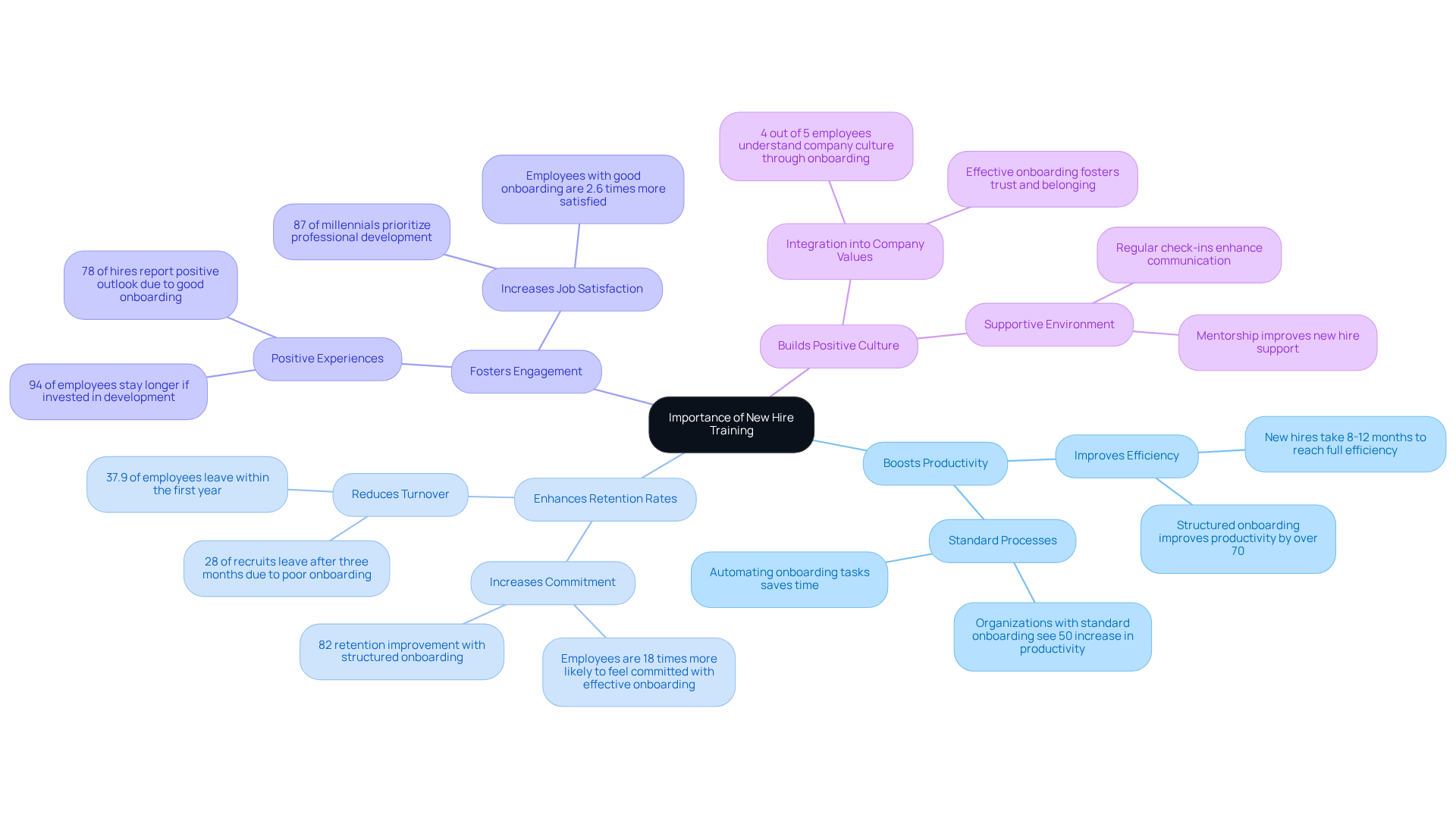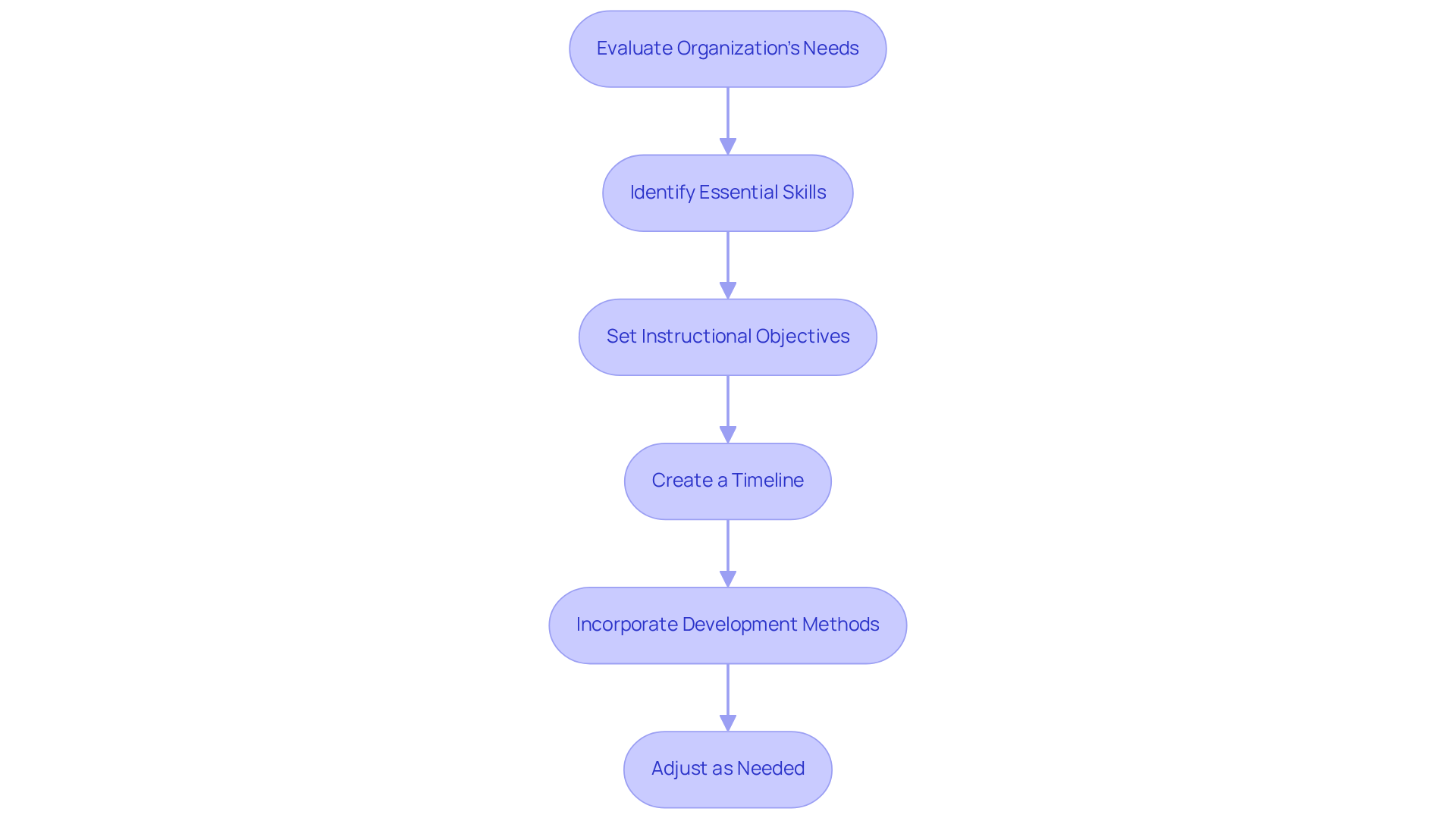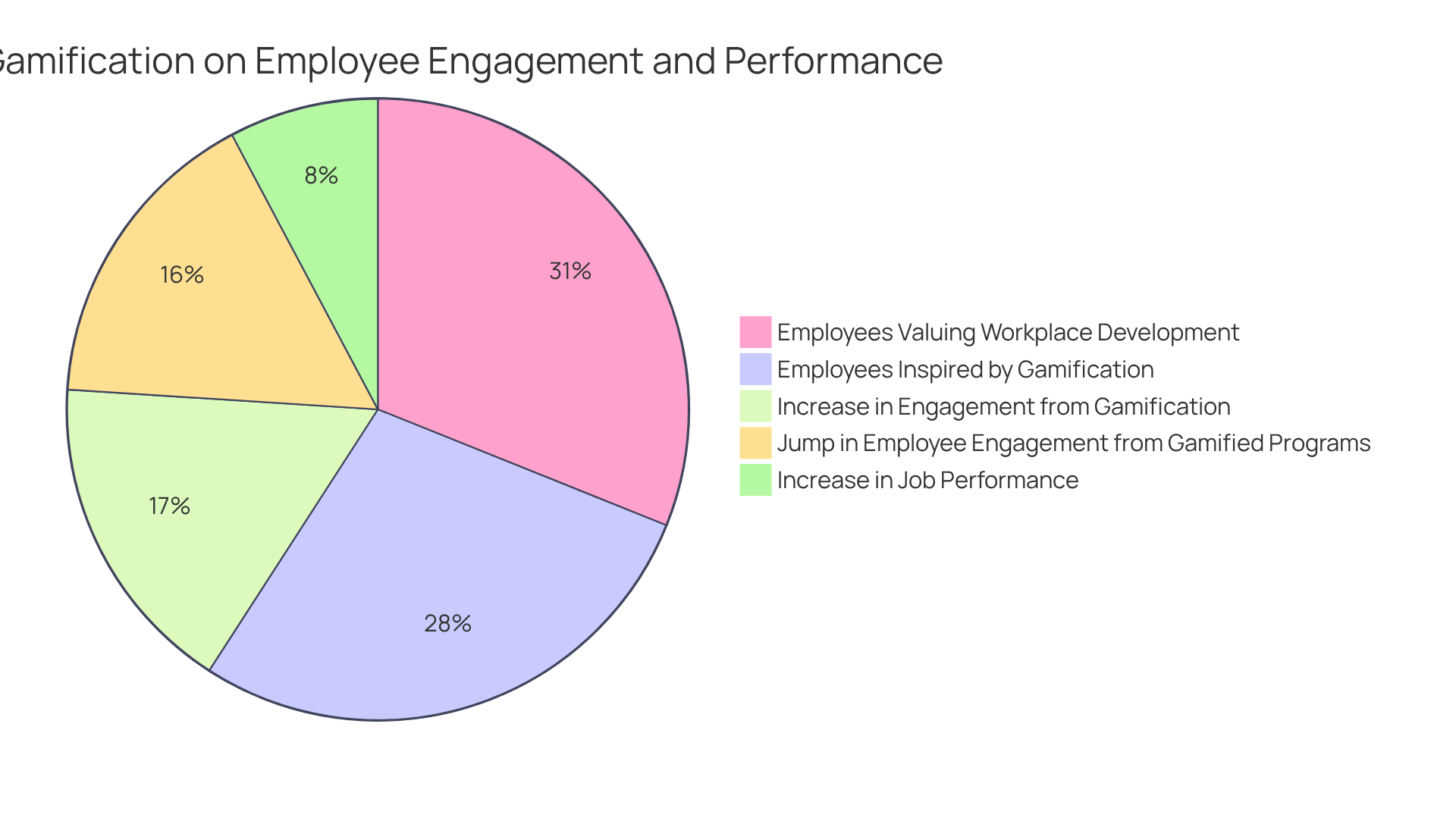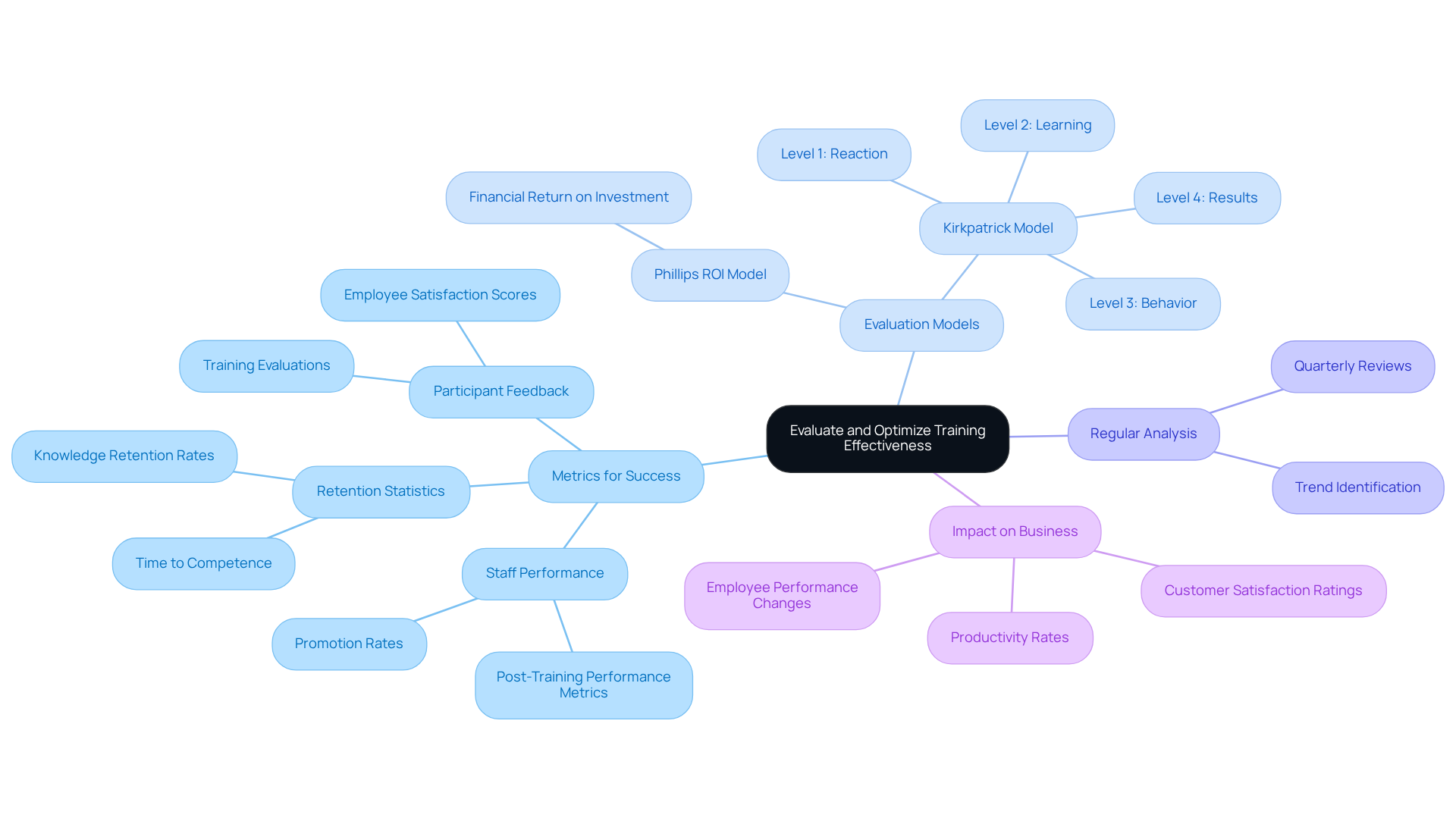
Streamlined Onboarding Processes
|
October 16, 2025
|
How to Train New Hires: Essential Steps for Operations Managers
Overview
You might be wondering how effective training for new hires really works. Well, it turns out that having a structured onboarding process can do wonders for productivity and retention. In fact, statistics show that well-implemented programs can cut turnover by as much as 82%! Isn’t that impressive?
Now, let’s dive into some strategies that can make a big difference:
- Tailored training plans
- Diverse learning methods
- Ongoing assessments
These are just a few ways to boost employee engagement. When these elements come together, they not only help employees feel more connected but also bring significant financial benefits to organizations. So, if you’re looking to enhance your onboarding process, consider these approaches and watch the positive impact unfold!
Key Highlights:
- Effective onboarding boosts productivity and retention rates by up to 82%, reducing turnover.
- Structured development programmes enhance employee engagement and contribute to a positive workplace culture.
- Organisations should evaluate specific training needs and set clear instructional objectives.
- Incorporating diverse training methods, including hands-on experiences and e-learning, caters to different learning styles.
- 94% of employees are more likely to stay at companies that invest in their career growth.
- Companies that invest in training see 218% more income per employee compared to those that don't.
- Employees acquire 70% of their skills on the job, emphasising the need for practical training.
- Gamification techniques can increase employee engagement by 50% and job performance by 23%.
- Supportive feedback and adaptive learning environments significantly impact job engagement.
- Regular assessment of training effectiveness through metrics like retention and performance is essential for continuous improvement.
- The Phillips ROI model and Kirkpatrick model are useful tools for evaluating training outcomes and financial returns.
Introduction
You might be wondering why effective onboarding is so crucial for successful operations management. Well, many organizations tend to overlook just how much it can influence employee retention and productivity. A solid training program doesn’t just arm new hires with the skills they need; it also helps them feel like they truly belong and are engaged at work. So, as operations managers look to improve their onboarding processes, the big question is: how can they craft a training strategy that meets organizational needs and also captivates and keeps talent in this ever-changing workforce?
Understand the Importance of New Hire Training
You might be wondering why effective onboarding is such a big deal. Well, it’s pretty simple—it demonstrates how to train new hires with the essential skills and knowledge they need to get their jobs done efficiently, which can really boost productivity. Did you know that structured onboarding can enhance retention rates by as much as 82%? That’s huge! It really highlights how important it is for reducing turnover.
But there’s more! that teaches how to train new hires not only helps them feel like they belong but also sparks engagement, which is key to building a positive workplace culture. So, operations managers, take note: investing in comprehensive development isn’t just a win for new hires; it also provides insights on how to train new hires effectively while enhancing the overall performance and stability of your organization. Now, let’s dive into how you can make onboarding even better!

Develop a Structured Training Plan
You might be wondering how to develop . Well, operations managers need to start by evaluating their organization's specific needs and understanding how to train new hires for their roles. This means identifying the essential skills and knowledge areas that need some attention. Once that’s sorted, it’s time to set clear instructional objectives and create a timeline for the sessions.
Now, let’s talk about mixing things up! Incorporating a variety of development methods—like hands-on experiences, e-learning modules, and mentorship opportunities—can really cater to different learning styles and preferences. Flexibility is key here; the development plan should be adjustable to reflect any changes in organizational goals or industry standards. This approach not only boosts staff engagement but also shows how to train new hires, aligning with the fact that 94% of workers are more likely to stick around at a company that invests in their career growth.
Plus, organizations that prioritize structured onboarding and understand how to train new hires can improve new employee retention by a whopping 82%. That really emphasizes how to train new hires with a well-thought-out development strategy. And here’s another interesting tidbit: companies that provide extensive training see 218% more income per employee than those that don’t. That’s a significant financial incentive to invest in staff development!
Speaking of skills, did you know that employees acquire 70% of their skills on the job and only 10% through ? This highlights the importance of incorporating hands-on training into your plan. To make this process even smoother, SowFlow offers an easy solution for creating user guides and updating documentation on the fly. This ensures that educational materials stay relevant and accessible.
This capability not only streamlines onboarding and knowledge sharing but also cuts down on unnecessary meetings, ultimately boosting team efficiency and productivity. So, why not explore how these strategies can work for you?

Implement Effective Training Strategies
You might be wondering how to make development strategies more effective. Well, integrating interactive elements can really engage new hires and enhance their understanding of how to train new hires. Imagine turning learning into a fun experience with gamification techniques like quizzes and challenges! Studies show that a whopping 83% of staff feel more inspired when skill development is gamified, leading to a 50% boost in engagement and a 23% increase in job performance. Plus, role-playing scenarios can mimic real-life situations, giving individuals practical experience that really strengthens their learning. For example, organizations that use gamified educational programs have seen a 48% jump in employee engagement levels—talk about correlation with improved retention rates!
Now, let’s talk about feedback. Supportive feedback during the development process is crucial for spotting areas that need improvement and tweaking techniques accordingly. Did you know that 92% of employees believe workplace development positively impacts their job engagement? This really highlights how important adaptive learning environments are. To enhance learning, it is crucial to consider how to train new hires by ensuring they have access to ongoing support and resources, like dedicated mentors or an online knowledge base. Organizations that prioritize thorough development programs see a staggering 218% greater revenue per staff member and enjoy a 24% increase in profit margin. It’s clear that investing in effective development strategies pays off financially! By the way, the gamification industry is projected to hit $25.7 billion by 2025, which shows just how vital it is becoming in workforce development.

Evaluate and Optimize Training Effectiveness
You might be wondering how to effectively assess and enhance learning effectiveness, right? Well, operations managers should start by establishing clear metrics for success. Think about staff performance improvements after instruction, retention statistics, and participant feedback. Using surveys and evaluations can provide valuable insights into the development experience and results. For instance, keeping an eye on how employees utilize the skills they learned can reveal just how well they're incorporating new knowledge into their daily tasks. A high utilization rate suggests that the instruction was relevant and practical.
Now, let’s dive into why regular analysis of this data is crucial. It helps managers identify trends and pinpoint areas needing adjustments in the development program. If you notice , it might indicate issues with engagement or content delivery, which could prompt a review of teaching methods. Plus, metrics like promotion rates can serve as indicators of program effectiveness, showing how well instruction prepares employees for advancement.
It's essential to frequently assess and refresh instructional resources to ensure they remain relevant and effective in addressing organizational needs. Have you heard of the Phillips ROI model? It’s a great tool for assessing the financial return on investment from educational initiatives. And then there’s the Kirkpatrick model, which provides a structured way to evaluate learning outcomes across four levels: reaction, learning, behavior, and results. By consistently refining the development process, organizations can boost staff performance and satisfaction. Ultimately, this fosters business growth and helps maintain a competitive edge in the marketplace. This proactive approach not only nurtures a culture of learning but also aligns training initiatives with broader business objectives, ensuring that investments in employee development yield tangible results.

Conclusion
You might be wondering why effective onboarding is such a big deal. Well, it’s not just a box to tick; it’s a smart investment that can really boost your organization’s productivity and help keep employees around longer. When operations managers roll out a structured training plan, they’re not just filling time—they’re giving new hires the essential skills and knowledge they need to thrive. This approach fosters a sense of belonging and engagement in the workplace. And the stats are impressive—structured onboarding can improve retention rates by up to 82%! That’s a game changer for reducing turnover and enhancing overall organizational stability.
Now, let’s break down some key steps for effective training:
- Developing a tailored training plan is crucial.
- Incorporating engaging strategies like gamification can make learning fun and effective.
- Ongoing evaluation and optimization of your training programs are important.
- Mixing up training methods to suit different learning styles is beneficial.
- Regularly checking how well these initiatives are working ensures onboarding processes are relevant and impactful.
And let’s be real—the financial benefits are huge; companies that prioritize training often see significantly higher revenue per employee.
In conclusion, investing in new hire training is absolutely essential. It’s about building a positive workplace culture, boosting employee satisfaction, and driving business success. So, operations managers, why not embrace these best practices and innovative training methods? Creating a solid onboarding experience will not only prepare new hires for their roles but also align with your organization’s bigger goals. By taking this proactive approach to employee development, you’re setting the stage for long-term success. It’s a win-win for both the workforce and the organization in today’s ever-evolving landscape.
Frequently Asked Questions
Why is effective onboarding important for new hires?
Effective onboarding is crucial because it teaches new hires the essential skills and knowledge they need to perform their jobs efficiently, ultimately boosting productivity.
How much can structured onboarding enhance retention rates?
Structured onboarding can enhance retention rates by as much as 82%, significantly reducing turnover.
What additional benefits does a well-structured development program provide?
A well-structured development program helps new hires feel a sense of belonging and sparks engagement, which is essential for building a positive workplace culture.
What is the impact of investing in comprehensive development for new hires?
Investing in comprehensive development not only benefits new hires but also provides insights on effective training methods while enhancing the overall performance and stability of the organization.
👍
What others are liking
5 Steps to outline your ideal documentation structure
5 MINS READ
Where to start the your journey of mapping out your ideal documentation structure, aligning it with the very heartbeat of your organization?
Defining a winning level of detail in your process
3 MINS READ
What is too much detail, and what is too little? This article described in that winning level detail about what detail is enough.





